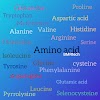Lysine | History | Structure | Chemical properties | Function....
LYSINE AMINO ACID
Lysine (symbol Lys or K) is an α-amino acid that is used in the biosynthesis of proteins. It contains an α-amino group, an α-carboxylic acid group, and a side chain lysyl ((CH2)4NH2), classifying it as a basic, charged (at physiological pH), aliphatic amino acid.
L-lysine is an essential amino acid. Normal requirements for lysine have been found to be about 8 g per day or 12 mg/kg in adults. Children and infants need more, 44 mg/kg per day for an eleven to-twelve-year old, and 97 mg/kg per day for three-to six-month old.
It is encoded by the codons AAA and AAG. Like almost all other amino acids, the α-carbon is chiral and lysine may refer to either enantiomer or a racemic mixture of both. The human body cannot synthesize lysine. It is essential in humans and must be obtained from the diet. In organisms that synthesise lysine, it has two main biosynthetic pathways, the diaminopimelate and α-aminoadipate pathways, which employ different enzymes and substrates and are found in different organisms. Lysine catabolism occurs through one of several pathways, the most common of which is the saccharopine pathway.
Lysine is one of nine essential amino acids in humans required for growth and tissue repair, Lysine is supplied by many foods, especially red meats, fish, and dairy products. Lysine seems to be active against herpes simplex viruses and present in many forms of diet supplements. The mechanism underlying this effect is based on the viral need for amino acid arginine; lysine competes with arginine for absorption and entry into cells. Lysine inhibits HSV growth by knocking out arginine.
Properties :-
Chemical formula :- C6H14N2O2
Molar mass :- 146.190 g·mol−1
Solubility in water :- 1.5 kg/L
Thermodynamic data :- Phase behaviour (solid–liquid–gas)
STRUCTURE -
 |
| Ferdinand Heinrich Edmund Drechsel |
Lysine was first isolated by the German biological chemist Ferdinand Heinrich Edmund Drechsel in 1889 from the protein casein in milk. He named it "lysin". In 1902, the German chemists Emil Fischer and Fritz Weigert determined lysine's chemical structure by synthesizing it.
SYNTHESIS :- Biosynthesis
Two different pathways have been identified in nature for the synthesis of lysine. The diaminopimelate (DAP) pathway belongs to the aspartate derived biosynthetic family, which is also involved in the synthesis of threonine, methionine and isoleucine. Whereas the α-aminoadipate (AAA) pathway is part of the glutamate biosynthetic family. The DAP pathway is found in both prokaryotes and plants and begins with the dihydrodipicolinate synthase (DHDPS) (E.C 4.3.3.7) catalysed condensation reaction between the aspartate derived, L-aspartate semialdehyde, and pyruvate to form (4S)-4-hydroxy-2,3,4,5-tetrahydro-(2S)-dipicolinic acid (HTPA). The product is then reduced by dihydrodipicolinate reductase (DHDPR) (E.C 1.3.1.26), with NAD(P)H as a proton donor, to yield 2,3,4,5-tetrahydrodipicolinate (THDP).
The AAA pathway involves the condensation of α-ketoglutarate and acetyl-CoA via the intermediate AAA for the synthesis of L-lysine. This pathway has been shown to be present in several yeast species, as well as protists and higher fungi. It has also been reported that an alternative variant of the AAA route has been found in Thermus thermophilus and Pyrococcus horikoshii, which could indicate that this pathway is more widely spread in prokaryotes than originally proposed. The first and rate-limiting step in the AAA pathway is the condensation reaction between acetyl-CoA and α‑ketoglutarate catalysed by homocitrate-synthase (HCS) (E.C 2.3.3.14) to give the intermediate homocitryl‑CoA, which is hydrolysed by the same enzyme to produce homocitrate. Homocitrate is enzymatically dehydrated by homoaconitase (HAc) (E.C 4.2.1.36) to yield cis-homoaconitate. HAc then catalyses a second reaction in which cis-homoaconitate undergoes rehydration to produce homoisocitrate. The resulting product undergoes an oxidative decarboxylation by homoisocitrate dehydrogenase (HIDH) (E.C 1.1.1.87) to yield α‑ketoadipate.
Use of lysine in animal feed :- Lysine production for animal feed is a major global industry, reaching in 2009 almost 700,000 tonnes for a market value of over €1.22 billion. Lysine is an important additive to animal feed because it is a limiting amino acid when optimizing the growth of certain animals such as pigs and chickens for the production of meat. Lysine supplementation allows for the use of lower-cost plant protein (maize, for instance, rather than soy) while maintaining high growth rates, and limiting the pollution from nitrogen excretion. In turn, however, phosphate pollution is a major environmental cost when corn is used as feed for poultry and swine. Lysine is industrially produced by microbial fermentation, from a base mainly of sugar. Genetic engineering research is actively pursuing bacterial strains to improve the efficiency of production and allow lysine to be made from other substrates.







0 Comments